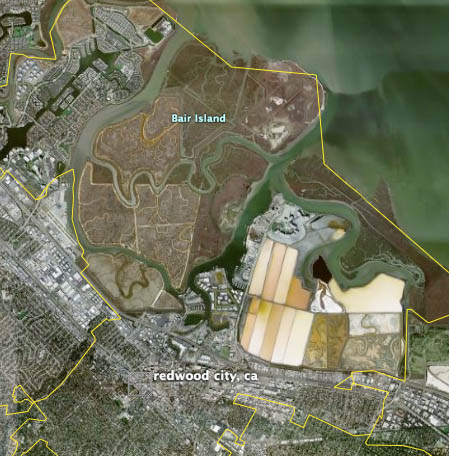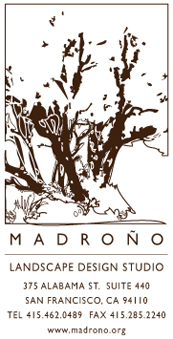 At the confluence of Redwood Creek and San Francisco Bay in southern San Mateo county, three islands shape-shift in drifting piles of river silt and sea salt. Boundaries may blur, but Smith and Corkscrew Sloughs divide this trio clearly into Inner, Middle, and Outer Bair Island -- the first a popular Redwood City jogging and dog-walking spot connected to the mainland at Whipple Ave., the latter two accessible by kayak. These sandbanks and mudflats have undulated over eons in a long, slow waltz between sedimentation from the river and erosion from the tides, creation and destruction inseparable.
At the confluence of Redwood Creek and San Francisco Bay in southern San Mateo county, three islands shape-shift in drifting piles of river silt and sea salt. Boundaries may blur, but Smith and Corkscrew Sloughs divide this trio clearly into Inner, Middle, and Outer Bair Island -- the first a popular Redwood City jogging and dog-walking spot connected to the mainland at Whipple Ave., the latter two accessible by kayak. These sandbanks and mudflats have undulated over eons in a long, slow waltz between sedimentation from the river and erosion from the tides, creation and destruction inseparable.
Here at the corner of ocean and land, the air hangs with the sharp aroma of salt and the healthy reek of decay and erumpent life. High tide deepens the channels between the raised flats; low tide reveals tangles of pickleweed connecting them. On higher ground, yellow blossoms of gumplant wave in the breeze, and pink rosemary blooms of alkali heath hug the ground -- a contrast to the stark rectangles of vivid red, orange, and white at the adjacent industrial salt ponds.
Tidal marshes in the San Francisco Bay provide critical habitat for a vast array of species including young salmon and steelhead adjusting to life in saltwater, harbor seals hauling out on the marshes to breed and whelp, shorebirds like snowy plovers, shovelers, avocets and black-neck stilts prowling the mudflats for mollusks, and endemic endangered birds and mammals like the California clapper rail and the salt marsh harvest mouse who live only in the tidelands of the Bay.
The salty smell of the marsh evokes ancient origins. Just as the first creatures arose from the primordial sea, modern-day mothers bring forth babies drenched in pregnancy's brine. The theme has expressed itself in human mythology from at least the time of Babylon, when Marduk (the god of storm) established lordship over the other deities by killing the chaotic Tiamat (saltwater) and creating the world out of Tiamat's body. This cleft between dry land and deep sea is the mother of us all.
The morphing shores of Bair Island could fill a bookshelf with tales. An early volume would describe the Ice Age, when the Pacific coast lay hundreds of miles further west and San Francisco Bay was a dry river basin. The next tome would tell of glaciers melting and sea levels rising, the great flood of 8000 B.C. when breakers breached the golden gate and the Bay was born. Subsequent books would outline the billions of birds stopping here on their migration along the Pacific flyway; the Ohlone, who hunted ducks and collected plants in these marshes for millennia; the Spanish colonials, who for several decades collected the Ohlone; fledgling Mexico, who could not hold the treasure she had won; and the United States, a young buck who picked up California in 1848 and rarely looks back.
Bair Island's tidal marshes were diked for agriculture in the late 19th century. Much of the region was converted to commercial salt ponds in 1946, and for the next 20 years the Cargill Salt Co. extracted mountains of sodium chloride from the mudflats. A series of real estate development companies bought the land in the late '60s, but their plans were thwarted by the city of Redwood City, after which Bair Island was purchased in portions as open space by the Don Edwards San Francisco Bay National Wildlife Refuge, the California Dept. of Fish and Game, and the Peninsula Open Space Trust. All three islands are now part of Don Edwards, the first urban national wildlife refuge established in the U.S. and a federal landmark celebrating its 30th birthday this year.
Today the drama comes full-circle: a Bair Island Restoration Plan proposes to remove the dikes and return 1,400 acres of former salt ponds to the ebb and flow of the sea. This plan is but one step of a much larger movement, the 15,000-acre South Bay Salt Pond Restoration Project, the west coast's largest tidal wetland restoration ever. It seeks to rehabilitate some of our richest wildlife habitat, of which 90-95% in the Bay area has been lost over the last two centuries.
While applauding best intentions, nobody can predict exactly what will happen when all that ocean advances upon so much earth. "Tug on anything at all," said John Muir, "and you'll find it connected to everything else in the universe." The simple act of removing the levees will change the relationship on many levels between elemental forces.
For example, increased volume of water in the region means that simple tidal swells could more easily flood the South Bay, as they did 20 years ago in Alviso and less than a decade ago in San Jose; rising global sea levels further compound this issue. Changes in water circulation may have positive or negative impacts on water quality, the former including higher levels of dissolved oxygen and summer water temperatures, the latter including re-suspension and increased resident times of mud-buried pollution. Tidal marsh restoration sometimes causes methylation of mercury, which boosts the quicksilver's absorption into the food chain; the restoration project will identify locations of mercury "hotspots" and other contaminants in the South Bay, and will study and attempt to reduce the potential for mercury methylation and other pollution problems. New tidal velocities may affect boaters in nearby Pete's harbor marina, while returning wildlife will raise the chances of bird strikes by planes out of adjacent San Carlos airport. Sudden alterations of nature also encourage invasive species -- like mosquitoes, ravens, and the notorious weedy cordgrass Spartina -- which require constant monitoring and often removal.
Despite the risks involved, genesis justifies its own means. When we act to strengthen the cycles of life, we create greater value for the future than whatever we may merely reap today.
The traditional season of harvest is, in California, a time to sow: October is the ideal month to plant or seed California natives in the landscape or garden. The still-warm days of Indian summer give potted specimens a few weeks to establish their root systems before the rains of winter, and seeds help their chances of germination by stratifying in situ before the deluge. Roots fed by this deep rainwater require no irrigation as they strengthen through the winter, bolstering a flush of growth in the coming spring.
The winds of autumn lift us through death to rebirth. This is the waltz of deep time, where age and youth intersect, where tragedy and comedy share one face. We are lucky to be seated at the table of life; please remember to pass the salt for future generations.
* * *
Today is Geoffrey Coffey's birthday. He is a freelance writer and the founder of the Madroño Landscape Design Studio.

